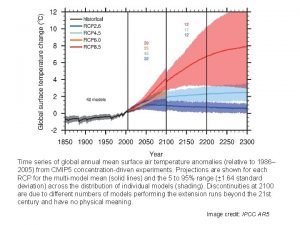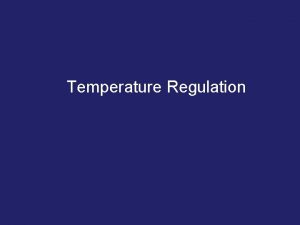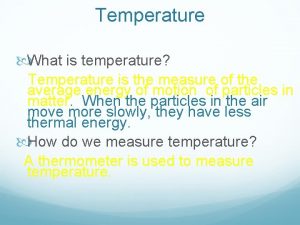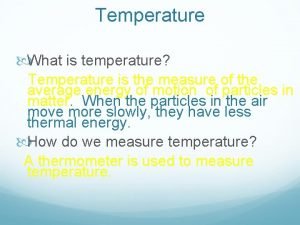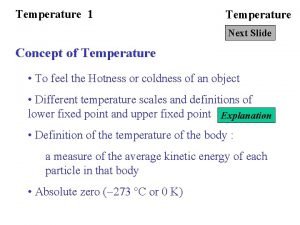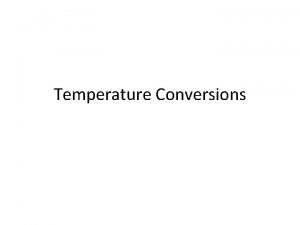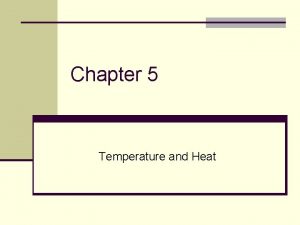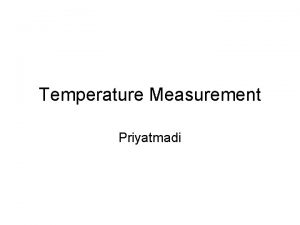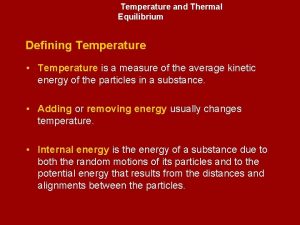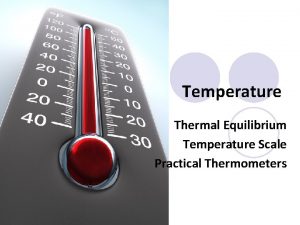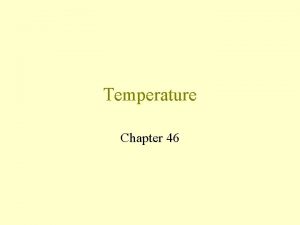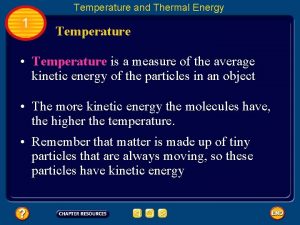Lecture 5 Air Temperature Air Temperature why its




















- Slides: 20

Lecture 5 Air Temperature

Air Temperature –why it’s important • It’s the first thing we usually think about when we talk about “weather” • Temperatures vary on different time scales – Seasonally, daily and even hourly l Temperatures vary all over the globe, by quite a bit.

Air Temperature – Day vs. Night Conduction • On a sunny calm day, the air near the surface warmer than air a meter or so above the surface. Radiation • On a clear, calm night, the air near the surface is colder than the air above. This is called a temperature inversion

Daily Variations in Temperature • Minimum right before sunrise No heat from sun, lots of IR energy emitted during night • Maximum after noon (peak) In = out Heat from sun + IR emitted up from the surface

Air Temperature • Daily mean temperature – Average of 24 hourly readings – Adding maximum and minimum and dividing by two. • Example Maximum Temperature: 45 Minimum Temperature: 31 Daily Mean Temperature: (45 + 31)/2 = 38

Air Temperature • Daily Temperature Range – The difference between the maximum and minimum daily temperatures • Example Maximum Temperature: 45 Minimum Temperature: 31 Daily Temperature Range: (45 - 31) = 14

Air Temperature • Monthly mean temperature – Adding together the daily means for each day of a month and then dividing by the number of days in that month • Example Sum of Daily Means: 1216 Number of Days: 28 Monthly Temperature Mean: (1216/28) = 43. 4

Air Temperature • Annual Mean Temperature – Adding together the monthly means and dividing by 12 Annual Means January: 49 February: 47 March: 52 • Example April: 60 May: 69 June: 75 July: 80 Sum of Monthly Means: 766 Number of Months: 12 August: : 83 September: 76 October: 65 November: 58 December 52 Annual Mean Temperature: (776/12) = 63. 8

Air Temperature • Annual Temperature Range –The difference between the warmest and coldest monthly mean temperatures • Example Warmest Monthly Mean Temperature: 43 Coldest Monthly Mean Temperature: 15 Annual Temperature Range: (43 - 15) = 28

What controls air temperature? • • • Differential Heating of Land Water Ocean Currents Altitude Geographic Position Cloud Cover and Albedo

Land Ocean – Differential Heating • Different surfaces absorb, emit and reflect different amounts of energy. – This causes variations in air above each surface

Land Ocean – Differential Heating • In general: Land HEATS more rapidly and to HIGHER temperatures than Water. • In general: Land COOLS more rapidly and to LOWER temperatures than Water.

Land Ocean – Differential Heating • Variations over Land are GREATER than variations over the Ocean!!! – The land surface has more variety…. • • • Trees Streets Buildings Fields Houses….

Ocean – Why is it less variable? 1. Surface temperature of water rises and falls slower than land 2. Water is highly mobile and mixes easily (think mixing red and blue dye… turns purple) 3. Daily changes are about 6 meters deep 4. Yearly, ocean and deep lakes experience variations through a layer between 200 -660 m thick!

Land – Why is it more variable? 1. Heat does not penetrate deeply into soil or rock; it remains near the surface. 2. Rocks are not fluid… so no mixing 3. Daily temperature changes are seen only 10 cm down 4. Yearly, temperature changes reach only 15 meters or less

Land Ocean – Summer vs. Winter • During summer a thick layer of water is heated while only a thin layer of land is heated. • During winter the shallow layer of rock cools rapidly while the deeply heated water takes a longer time to cool. – as surface water cools it becomes heavier and sinks, replaced with warmer less dense water from below…. • This means the surface temperature of water doesn’t appear to change much

Land Ocean – opaque vs. transparent • Because land surfaces are opaque heat is absorbed only at the surface • Water is transparent and lets energy from the sun penetrate to a depth of several meters

Land Ocean – Specific Heat • The specific heat – the amount of heat needed to raise the temperature of 1 gram of water by 1 degree Celsius is greater (~3 times) than to do the same for 1 gram of soil/rock. ¡ The OCEANS require MORE heat to raise its temperature the same amount as an equal quantity (grams) of land.

Land Ocean – Evaporation • Evaporation is greater from Oceans than from Land – There’s more water molecules – Energy is required to evaporate water – When energy is used to evaporate water it is not available for heating. WATER WARMS MORE SLOWLY THAN LAND!!

Class Question? ? • Which Hemisphere (north or south) has larger temperature variations? The Northern Hemisphere has greater variations in temperature than the Southern Hemisphere • Why? ? There is more ocean than in the Southern Hemisphere. There is little land to interrupt the oceanic and atmospheric circulation. Thus, the SH has smaller variations in temperature.
 Pictures
Pictures Conceptual physical science 5th edition
Conceptual physical science 5th edition 01:640:244 lecture notes - lecture 15: plat, idah, farad
01:640:244 lecture notes - lecture 15: plat, idah, farad Barometer
Barometer Don't ask why why why
Don't ask why why why Hubungan air dengan tanah
Hubungan air dengan tanah Difference between curie temperature and neel temperature
Difference between curie temperature and neel temperature Difference between curie temperature and neel temperature
Difference between curie temperature and neel temperature Ferrimagnetism
Ferrimagnetism Emigree poem summary
Emigree poem summary When a train increases its velocity its momentum
When a train increases its velocity its momentum Sunny cloudy rainy windy
Sunny cloudy rainy windy If its square its a sonnet summary
If its square its a sonnet summary Its halloween its halloween the moon is full and bright
Its halloween its halloween the moon is full and bright Its not easy but its worth it
Its not easy but its worth it What happens when the temperature of the air cools brainpop
What happens when the temperature of the air cools brainpop Global mean surface air temperature
Global mean surface air temperature Brainpop thunderstorms
Brainpop thunderstorms What happens when the temperature of the air cools brainpop
What happens when the temperature of the air cools brainpop Brainpop1
Brainpop1 Two vocal style of singing in pakistan
Two vocal style of singing in pakistan
















